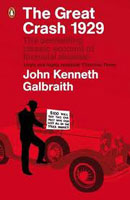 Wonderful reading for the end of yet another year of financial meltdown, and a book which provides a short historical background for discussions as to whether we are facing another “Great Depression.” We aren’t there yet, as Galbraith’s opening lines make clear.
Wonderful reading for the end of yet another year of financial meltdown, and a book which provides a short historical background for discussions as to whether we are facing another “Great Depression.” We aren’t there yet, as Galbraith’s opening lines make clear.
“Some years, like some poets and politicians and some lovely women, are singled out for fame far beyond the common lot, and 1929 was clearly such a year.”
No one (yet) talks about 2007 or 2008 in that way, and perhaps that’s as a result of lessons learned. Galbraith wrote the book in 1954, and his stated purpose was as follows:
“…a good knowledge of what happened in 1929 remains our best safeguard against the recurrence of the more unhappy events of those days…. The wonder, indeed, is that since 1929 we have been spared so long. One reason, without doubt, is that the experience of 1929 burned itself so deeply into the national consciousness. It is worth hoping that a history such as this will keep bright that immunizing memory for a little longer.”
Assuming the facts of the stock market crash of 1929 are reasonably well known (there was a stock market bubble, then a crash), the real point of reading the book today is the wit with which Galbraith tells the story and the manner in which he examines the links between the crash and the Great Depression that followed.
The wit is evident everywhere, though difficult to demonstrate with only short quotes. The helplessness of the men of business in the face of stock market panic is well described, as they held meeting and meeting, not for any reason other than to create the impression that something was being done to bring the situation under control. As Galbraith puts it, the present tense indicating that he believes his observations are as relevant as ever, such meetings are
“… called not because there is business to be done, but because it is necessary to create the impression that business was being done…. such meetings are more than a substitute for action. They are widely regarded as action.”
And he ends with
“Even the commonplace observation of the head of a large corporation is still the statement of the head of a large corporation. What it lacks in content it gains in power from the assets behind it.”
The examination of whether the crash caused the Great Depression is in Chapter 10 – Cause and Consequence. Galbraith looks at all the theories, including the idea that depression was inevitable in the thirties. “There had been (at least) seven good years; now by occult or by biblical law of compensation there would have to be seven bad ones.”
He also lists the five weaknesses that seem to have had “an intimate bearing on the ensuing disaster.” It’s impossible to read these without considering how many might apply today. They are (1) the bad distribution of income and (2) the bad corporate structure (sound familiar so far?), the (3) bad banking structure, (4) the dubious state of the foreign balance (oh dear, that’s four out of the five) and the poor state of economic intelligence.
By this final weakness Galbraith means “… the economists and those who offered economic counsel in the late twenties and early thirties were almost uniquely perverse.” Of course today we have those advocating huge government expenditure to get us out of the recession, and those recommending financial austerity, Keynes versus Hayek. Perhaps that makes five out of five.
So can it happen again? Well of course we know the answer, from the dot com boom through to the housing market and subsequent crash. Galbraith knew the answer as well.
“…no one can doubt that the American people remain susceptible to the speculative mood…. a rising market can still bring the reality of riches. This in turn can draw more and more people to participate.”
So why don’t governments do more?
“The government preventatives and controls are ready… [but] there are a hundred reasons why a government will determine not to use them. In our democracy an election is in the offing even on the day after an election…. Action to break up a boom must always be weighed against the chance that it will cause unemployment at a politically inopportune moment.”
As he concludes,
“When it comes to many losing money, no one wants the disadvantage of being identified as the executioner….. inaction will be advocated in the present even though it means deep trouble in the future…. It is what causes men who know that things are going quite wrong to say that things are fundamentally sound.”
It’s a marvellous book, short, pithy and can be read straight through in a couple of hours – well worth the time.








